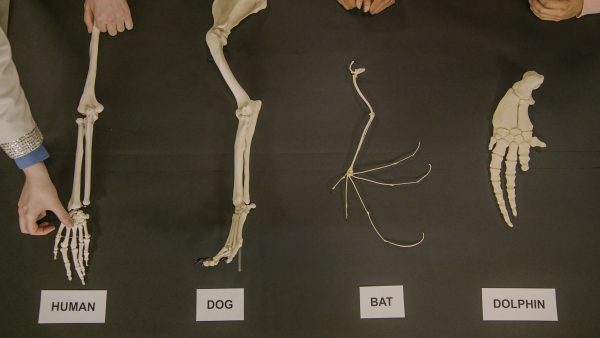Comparative Anatomy Definition
Comparative anatomy is observing similar structures in organisms and comparing them to each other. For example, studying skeletons to trace lineage.
View Lesson on Comparative Anatomy
Become a member to get full access to our entire library of learning videos, reading material, quiz games, simple DIY activities & more.
Become a member to get full access to our entire library of learning videos, quiz games, & more.
Plans & Pricingto watch this full video.

Access All Videos
and Lessons, No Limits.
Access All Videos

No credit card required,
takes 7 sec to signup.
No card required

Ready-to-go lessons
that save you time.
Ready-to-go lessons
If you are on a school computer or network, ask your tech person to whitelist these URLs:
*.wistia.com, fast.wistia.com, fast.wistia.net, embedwistia-a.akamaihd.net
Sometimes a simple refresh solves this issue. If you need further help, contact us.
Comparative Anatomy
Fun Facts
- Through comparative anatomy we know that bald eagles, Komodo dragon, and lizards all have skulls that connect directly to their spines.
- Comparative anatomy shows that dogs, dolphins, bats, and humans have a similar upper arm bone structure.
- By comparing the anatomy of male and female human skeletons, we know that males have slightly wider shoulders and females have slightly wider pelvises.
Why Do We Need To Know About Comparative Anatomy
Comparative anatomy helps us understand how different living things share similar body parts and why this is important for science and medicine. For example, scientists studying how babies develop can find out how certain chemicals might cause birth defects. This is key for warning pregnant women about what substances to avoid.
Veterinarians also use knowledge of comparative anatomy to treat many kinds of animals, from pets to wild animals. This helps them care for animals they may not see often. Plus, doing things like dissecting owl pellets to see how rodent and human bones compare shows how fun and useful learning about comparative anatomy can be. It helps us appreciate nature more.
Frequently Asked Questions
Check out the Full Lesson on Comparative Anatomy
In this lesson, we learn that:
- Human anatomy is similar to the anatomy of many other organisms.
- Humans develop from an embryo with a temporary tail.
- Scientists look at fossils to see how the anatomy of organisms has changed over time.
Related Topics
- Atom Definition
- Bioindicator Definition
- Camouflage Definition
- Cast Fossils Definition
- Chemical Reaction Definition
- Comparative Anatomy Definition
- Definition Of Extreme Weather
- Definition Of Non-living Things
- Definition Of Science
- Earth’s Orbit Definition
- Electricity Definition
- Electromagnetic Radiation Definition
- Endoskeleton Definition
- Energy Transfer Definition
- Environment Definition
- Erosion Definition
- Friction Definition
- Generator Definition
- Genetic Factors Definition
- Hearing Definition
- Keystone Species Definition
- Light Source Definition
- Melting Definition
- Metamorphosis Definition
- Mutualism Definition
- Natural Selection Definition
- Nonrenewable Resource Definition
- Particle Model Of Matter Definition
- Phases Of The Moon Definition
- Physical Change Definition
- Pollination Definition
- Prevailing Winds Definition
- Prey Definition
- Rain Definition
- Reactants Definition
- River Definition
- Scientific Name Definition
- Season Definition
- Solubility Definition
- Species Definition
- Sunlight Definition
- Texture Definition
- Translucent Definition
- Transverse Wave Definition
- Virus Definition
- Water Cycle Definition
- Weather Front Definition
- Wind Erosion Definition
Start a Free Trial Today. Get a $5 Amazon Gift Card!
Teachers! Start a free trial & we'll send your gift card within 1 day. Only cards left. Try it now.
Select Grade
Select Subject
This email is associated with a Science Kit subscription. Kit subscriptions are managed on this separate page: Manage Subscription

-
Download InvoiceScience & Math$/yr
-
Download InvoiceScience Only$/yr

access all lessons
• No credit card required •
"My students loved the videos. I started the video subscription in May and used them as a review before the state test, which I know contributed to 100% of my class passing the state test."
Rhonda Fox 4th Grade Teacher, Ocala, Florida
• No credit card required •
"My students loved the videos. I started the video subscription in May and used them as a review before the state test, which I know contributed to 100% of my class passing the state test."
Rhonda Fox 4th Grade Teacher, Ocala, Florida
• No credit card required •
Already a member? Sign In
* no credit card required *

* no credit card required *
* no credit card required *


no credit card required
Skip, I will use a 3 day free trial
Enjoy your free 30 days trial
-
Unlimited access to our full library
of videos & lessons for grades K-5. -
You won’t be billed unless you keep your
account open past your 14-day free trial. -
You can cancel anytime in 1 click on the
manage account page or by emailing us.
-
Unlimited access to our full library of videos & lessons for grades K-5.
-
You won't be billed unless you keep your account open past 14 days.
-
You can cancel anytime in 1-click on the manage account page.
Cancel anytime in 1-click on the manage account page before the trial ends and you won't be charged.
Otherwise you will pay just $10 CAD/month for the service as long as your account is open.
Cancel anytime on the manage account page in 1-click and you won't be charged.
Otherwise you will pay $10 CAD/month for the service as long as your account is open.
We just sent you a confirmation email. Enjoy!
DoneWe use cookies to make your experience with this site better. By using this site you agree to our use of cookies. Click "Decline" to delete and block any non-essential cookies for this site on this specific property, device, and browser. Please read our privacy policy for more information on the cookies we use.Learn More
We use cookies to improve your experience. By using this site, you agree to our use of cookies. Click "Decline" to block non-essential cookies. See our privacy policy for details.Learn More



























































































































